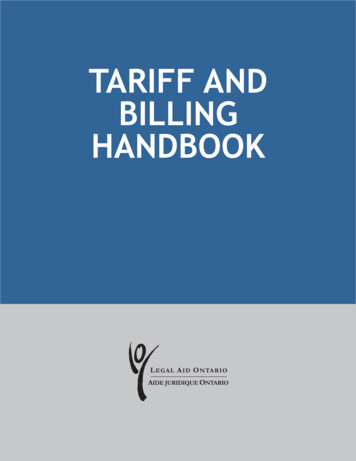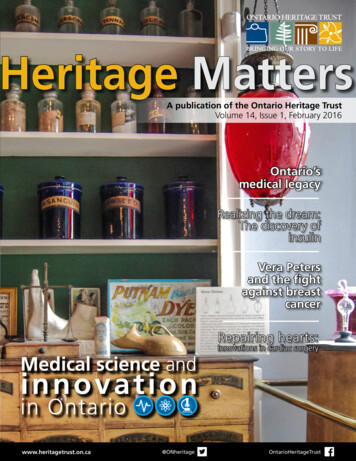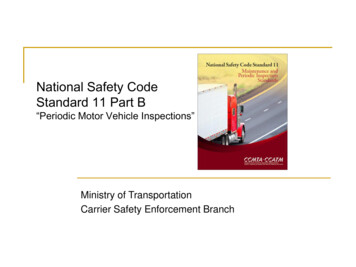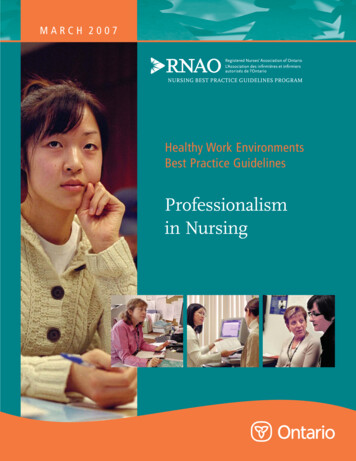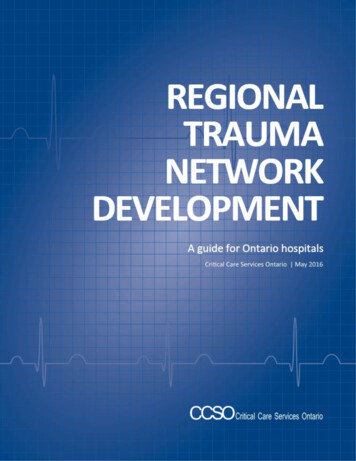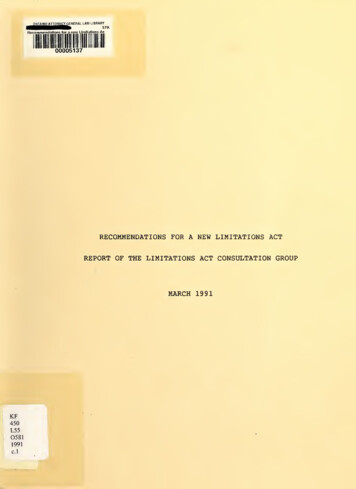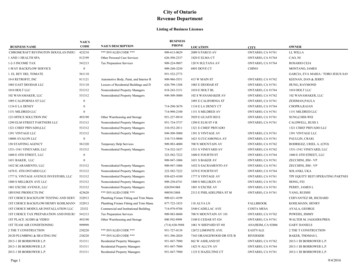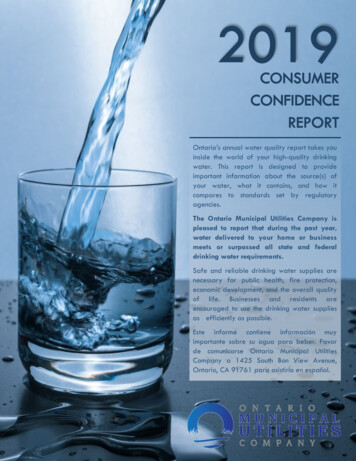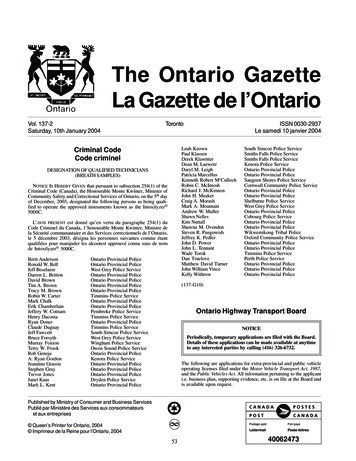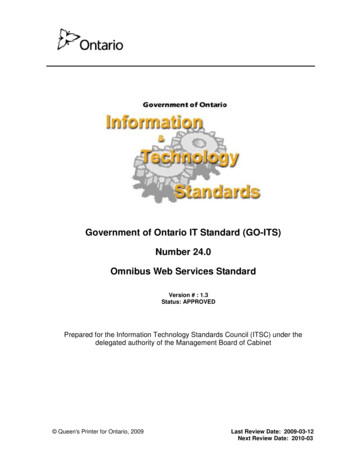
Transcription
Government of Ontario IT Standard (GO-ITS)Number 24.0Omnibus Web Services StandardVersion # : 1.3Status: APPROVEDPrepared for the Information Technology Standards Council (ITSC) under thedelegated authority of the Management Board of Cabinet Queen's Printer for Ontario, 2009Last Review Date: 2009-03-12Next Review Date: 2010-03
GO-ITS 24.0 Queen's Printer for Ontario, 2009Status: Approved2Version 1.3Last Review Date: 2009-03-12Next Review Date: 2010-03
GO-ITS 24.0Status: ApprovedVersion 1.3ForewordGovernment of Ontario Information Technology Standards (GO-ITS) are the official publications onthe guidelines, preferred practices, standards and technical reports adopted by the InformationTechnology Standards Council (ITSC) under delegated authority of the Management Board ofCabinet (MBC). These publications support the responsibilities of the Ministry of GovernmentServices (MGS) for coordinating standardization of Information & Information Technology (I&IT) in theGovernment of Ontario. Publications that set new or revised standards provide enterprise architectureguidance, policy guidance and administrative information for their implementation. In particular, GOITS describe where the application of a standard is mandatory and specify any qualificationsgoverning the implementation of standards. Queen's Printer for Ontario, 20093Last Review Date: 2009-03-12Next Review Date: 2010-03
GO-ITS 24.0Status: ApprovedVersion 1.3Table of Contents1. INTRODUCTION . 71.1 BACKGROUND AND PURPOSE . 71.2 TARGET AUDIENCE . 71.3 DOCUMENT SCOPE. 71.3.1 In Scope . 71.3.2 Out of Scope . 71.4 APPLICABILITY STATEMENTS . 81.5 REQUIREMENTS LEVELS . 81.6 RECOMMENDED VERSIONING AND/OR CHANGE MANAGEMENT . 91.7 PUBLICATION DETAILS . 92. COMPLIANCE REQUIREMENTS . 103. INTEROPERABILITY . 113.1 INTRODUCTION TO INTEROPERABILITY. 113.1.1 Web Services . 113.2 APPROACH TO INTEROPERABILITY . 113.2.1 Documenting Service Interfaces . 123.2.2 Using Web Services Profiles and their Component Standards . 123.2.3 Adopting Web Services Standards . 134. MANDATORY REQUIREMENTS: DOCUMENTING INTERFACE SPECIFICATIONS . 154.1 MANDATORY INTERFACE DESCRIPTION . 165. MANDATORY REQUIREMENTS: WEB SERVICES PROFILES . 175. MANDATORY REQUIREMENTS: WEB SERVICES PROFILES . 175.1 WS-I BASIC PROFILE VERSION 1.1. 175.2 WS-I BASIC SECURITY PROFILE VERSION 1.0. 185.3 SIMPLE SOAP BINDING PROFILE (SSBP) VERSION 1.0 . 195.4 WS-ATTACHMENTS PROFILE 1.0 . 196. MANDATORY REQUIREMENTS: WEB SERVICES . 216.1 BUSINESS PROCESSES . 216.1.1 Choreography Description Language 1.0 . 216.2 RELIABILITY . 216.2.1 Web Services Reliable Messaging (WS-ReliableMessaging) Version 1.1 . 216.2.2 Web Services Reliable Messaging Policy Assertion (WS-RM Policy) Version 1.1 . 226.3 SECURITY . 236.3.1Web Services Secure Conversation Language (WS-SecureConversation) . 236.3.2 Web Services Security: SOAP Message Security (WS-Security) 1.1 . 236.3.3 Web Services Security Addendum . 246.3.4 Web Services Security Kerberos Token Profile Version 1.1 . 256.3.5 Web Services Security (WS-Security) Username Token Profile 1.1 . 256.3.6 Web Services Security Policy (WS-SecurityPolicy) Version 1.2 . 266.3.7 Web Services Trust (WS-Trust) Version 1.3 . 266.4 SAML V1.1 SPECIFICATIONS (OASIS W EB SERVICES). 276.4.1 Security Assertion Markup Language V1.1 (SAML) . 276.4.1.1 Technical Overview of the OASIS Security Assertion Markup Language (SAML) V1.1 –OASIS Standard . 27 Queen's Printer for Ontario, 20094Last Review Date: 2009-03-12Next Review Date: 2010-03
GO-ITS 24.0Status: ApprovedVersion 1.36.4.1.2 Assertions and Protocol for the OASIS Security Assertion Markup Language (SAML)V1.1 – OASIS Standard . 276.4.1.3 Bindings and Profiles for the OASIS Security Assertion Markup Language (SAML) V1.1– OASIS Standard . 276.4.1.4 Security and Privacy Considerations for the OASIS Security Assertion MarkupLanguage (SAML) V1.1 – OASIS Standard . 286.4.1.5 Conformance Program Specification for the OASIS Security Assertion MarkupLanguage (SAML) V1.1 – OASIS Standard . 286.4.1.6 Glossary for the OASIS Security Assertion Markup Language (SAML) V1.1 – OASISStandard . 286.4.1.7 Assertion Schema for the OASIS Security Assertion Markup Language (SAML) V1.1 –OASIS Standard . 286.4.1.8 Protocol Schema for the OASIS Security Assertion Markup Language (SAML) V1.1 –OASIS Standard . 286.4.1.9 Errata for the OASIS Security Assertion Markup Language (SAML) V1.1. 296.4.1.10 Issues List for Security Assertion Markup Language (SAML) V1.1 . 296.4.1.11 Differences between OASIS Security Assertion Markup Language (SAML) V1.1 andV1.0 . 296.5 TRANSACTIONS . 296.5.1 Web Services Atomic Transaction (WS-Atomic Transaction) Version 1.0 . 296.5.2 Web Services Coordination (WS-Coordination) Version 1.1 . 306.6 DESCRIPTION AND DISCOVERY . 306.6.1 Universal Description Discovery and Integration (UDDI) Version 2.0 . 306.6.2 Web Services Description Language (WSDL) Version 1.1 . 316.6.3 Web Services Semantics (WSDL-S) Version 1.0 . 326.6.4 Web Services Metadata Exchange (WS-MetadataExchange) Version 1.1 . 326.6.5 Web Services Policy Assertions (WS-PolicyAssertions) Language Version 1.1 . 336.6.6 Web Services Policy 1.5 – Attachment (WS-PolicyAttachment) . 336.6.7 Web Services Policy Framework (WS-Policy) 1.2 . 346.7 MESSAGING . 356.7.1 Simple Object Access Protocol (SOAP) Version 1.1 . 356.7.2 Web Services Addressing (WS-Addressing). 356.7.3 Web Services Message Transmission Optimization Mechanism (WS-MTOM) . 366.7.4 Web Services for Remote Portlets (WSRP) . 367. NON-MANDATORY . 387.1 NON-MANDATORY XACML SPECIFICATIONS (OASIS W EB SERVICES) . 387.1.1 Extensible Access Control Markup Language (XACML) . 387.1.1.1 Extensible Access Control Markup Language (XACML) Version 1.1 – OASIS Standard. 387.1.1.2 Policy Schema for the Extensible Access Control Markup Language (XACML) Version1.1 – OASIS Standard . 387.1.1.3 Context Schema for the Extensible Access Control Markup Language (XACML)Version 1.1 – OASIS Standard . 387.1.1.4 Extensible Access Control Markup Language (XACML) Version 2.0 – OASIS Standard. 387.1.1.5 Policy Schema for the Extensible Access Control Markup Language (XACML) Version2.0 – OASIS Standard . 387.1.1.6 Context Schema for the Extensible Access Control Markup Language (XACML)Version 2.0 – OASIS Standard . 397.1.1.7 SAML 2.0 Profile of XACML – OASIS Standard . 397.1.1.8 SAML 2.0 Assertion Extension Schema – OASIS Standard . 397.1.1.9 SAML 2.0 Protocol Extension Schema – OASIS Standard . 397.1.1.10 XML Digital Signature Profile of XACML – OASIS Standard . 397.1.1.11 Privacy Policy Profile of XACML – OASIS Standard . 397.1.1.12 Hierarchical Resource Profile of XACML – OASIS Standard . 407.1.1.13 Multiple Resource Profile of XACML – OASIS Standard . 40 Queen's Printer for Ontario, 20095Last Review Date: 2009-03-12Next Review Date: 2010-03
GO-ITS 24.0Status: ApprovedVersion 1.37.1.1.14 Core and Hierarchical Role Based Access Control (RBAC) Profile of XACML – OASISStandard . 407.3 NON-MANDATORY BUSINESS PROCESSES SPECIFICATIONS . 417.3.1 Web Services Business Process Execution Language (WS-BPEL) Ver. 2 . 417.4 NON-MANDATORY W EB SERVICES PROVISIONING SPECIFICATIONS . 417.4.1 Web Services Provisioning Specifications (WS-Provisioning – draft) . 418. RELATED STANDARDS . 438.1 IMPACTS TO EXISTING STANDARDS. 438.2 IMPACTS TO EXISTING ENVIRONMENT . 439. CONTACT INFORMATION. 4410. ACKNOWLEDGEMENTS . 4510.1 EDITORS . 4510.2 CONTRIBUTORS . 4510.3 CONSULTATIONS . 4511. DOCUMENT HISTORY . 4612. COPYRIGHT INFORMATION . 46APPENDIX A: GLOSSARY . 47APPENDIX B: LIST OF WEB SERVICES STANDARDS DEVELOPMENT ORGANIZATIONS &VENDOR CONSORTIUMS . 48APPENDIX C: SERVICE MODEL TEMPLATE . 49 Queen's Printer for Ontario, 20096Last Review Date: 2009-03-12Next Review Date: 2010-03
GO-ITS 24.0Status: ApprovedVersion 1.31. Introduction1.1 Background and PurposeThe Omnibus standards; 24.0, 24.1 and 24.2 provide the foundation for the realization of an open andinteroperable I&IT environment in the OPS. Each of the Omnibus standards promotes the use ofopen standards developed by recognized standards development organizations and consortiums.They each provide an integrated set of standards designed to work together to support solutioninteroperability within the two supported OPS development environments (.NET and Java).Omnibus 24.2 defines the technical environment for networking and connectivity. Omnibus 24.0defines a web services interface environment and 24.1 defines the information, content andpresentation environment. Together these standards position the OPS to take advantage of ServiceOriented Architecture (SOA) frameworks in the future, which hold the greatest potential for loweringintegration costs and increasing flexibility across multiple solutions in a shared (consolidated)infrastructure environment.The Omnibus standards align with, and are designed to be implemented with, other importantGovernment of Ontario IT Standards including GO-ITS 54 Application Development Standardwhich specifies application development requirements in the OPS, GO-ITS 20.1 Platform SoftwareStandard which defines the two OPS standardized IT environments (.NET and Java), and GO-ITS23.1 Government of Ontario Public Web Standard.1.2 Target AudienceGO-ITS 24 Omnibus Standards apply to all Government of Ontario technology solutions providers,application development and integration.1.3 Document Scope1.3.1 In ScopeThis standard focuses on web services. Other standards that impact interoperability, Really SimpleSyndication/Rich Site Summary (RSS), Cascading Style Sheets (CSS), Atom, etc., are out of scopeand will be addressed in other GO-ITS as appropriate.Included in the scope of this document are : Technical standards from recognized national and international Standards DevelopmentOrganizations (SDOs) that are relevant when web services are being developed or used Business standards and specifications, e.g. WS-BPEL, WS-Coordination and other standardsand specifications that extend service concepts Web Services standards and specifications – WS-I specifications serve as a foundation forbasic, secure and reliable secure Web Services; these standards apply whenever a webservices approach is being used1.3.2 Out of Scope Mandating the use of SOA Queen's Printer for Ontario, 20097Last Review Date: 2009-03-12Next Review Date: 2010-03
GO-ITS 24.0 Status: ApprovedVersion 1.3Architecture best practices, frameworks, governance, methodologies and principles related toService Oriented Architecture (SOA)Information use, retention, disclosure and disposal policies, regulations or statutes that applyto the OPS, as well as any information asset safeguarding requirements of the OPS (e.g.,Statutes, legislation, regulations or OPS-specific directives or standards regarding I&ITsecurity and privacy)Monitoring and compliance mechanisms for adherence to this standards documentService Level Agreements (SLAs), performance metrics and quality assurance measuresVendor products that can form the basis of, or enable Web Services and SOA includingprocurement policies and strategies involving acquisition of vendor products and services1.4 Applicability StatementsGovernment of Ontario IT Standards and Enterprise Products apply (are mandatory) for use by allministries/clusters and to all former Schedule I and IV provincial government agencies under theirpresent classification (Advisory, Regulatory, Adjudicative, Operational Service, OperationalEnterprise, Trust or Crown Foundation) according to the current agency classification system.Additionally, this applies to any other new or existing agencies designated by Management Board ofCabinet as being subject to such publications, i.e. the GO-ITS publications and enterprise products and particularly applies to Advisory, Regulatory, and Adjudicative Agencies (see also procurementlink, OPS paragraph). Further included is any agency which, under the terms of its Memorandum ofUnderstanding with its responsible Minister, is required to satisfy the mandatory requirements set outin any of the Management Board of Cabinet Directives (cf. Operational Service, OperationalEnterprise, Trust, or Crown Foundation Agencies).As new GO-IT standards are approved, they are deemed mandatory on a go-forward basis (Goforward basis means at the next available project development or procurement opportunity).When implementing or adopting any Government of Ontario IT standards or IT standards updates,ministries and I&IT Clusters must follow their organization's pre-approved policies and practices forensuring that adequate change control, change management and risk mitigation mechanisms are inplace and employed.For the purposes of this document, any reference to ministries or the Government includes applicableagencies.Refer to section 2.0 Compliance Requirements for more information.1.5 Requirements LevelsWithin this document, certain wording conventions are followed. There are precise requirements andobligations associated with the following terms:MustThis word, or the terms "REQUIRED" or "SHALL", means that the statement is anabsolute requirement.ShouldThis word, or the adjective "RECOMMENDED", means that there may exist validreasons in particular circumstances to ignore the recommendation, but the fullimplications (e.g., business functionality, security, cost) must be understood andcarefully weighed before Queen's Printer for Ontario, 20098Last Review Date: 2009-03-12Next Review Date: 2010-03
GO-ITS 24.0Status: ApprovedVersion 1.31.6 Recommended Versioning and/or Change ManagementEach of the three Omnibus Standards package together many inter-related standards that have beendeveloped by several different standards development organizations and consortiums. The individualstandards development organizations will each be monitored for changes (minor and substantive) totheir respective standards and specifications on a regular basis, every six months. As they evolve, theOmnibus standard that references them will also be updated to reflect the changes. When thechanges collectively reach a stage where they have a material impact on the implementation of thestandard, then the respective Omnibus standard will be brought forward to Information TechnologyStandards Council (ITSC) and the Architecture Review Board (ARB) for review and approval, as perthe approved governance process for all Government of Ontario IT Standards (GO-ITS).It is important to note that, as with all GO-ITS, the Omnibus standards are meant to align with, andsupport other related GO-ITS such as the GO-ITS 20.1 Platform Software Standard, therefore ifthere are updates made to related standards this may also trigger updates to the Omnibus standards.1.7 Publication DetailsAll approved Government of Ontario IT Standards (GO-ITS) are published on the ITSC Intranet website. Please indicate with a checkmark below if this standard is also to be published on the public,GO-ITS Internet Site.Standard to be published on both the OPS Intranet and the GO-ITSInternet web site (available to the public, vendors etc.) Queen's Printer for Ontario, 20099 Last Review Date: 2009-03-12Next Review Date: 2010-03
GO-ITS 24.0Status: ApprovedVersion 1.32. Compliance RequirementsAll OPS projects/solutions proceeding through the Corporate Gating Process will be required tocomplete the Interface Definition information. An interface definition template is found in section 4.0 ofthis document.In addition, all OPS projects/solutions proceeding through the Corporate Gating Process areexpected to implement a web services approach where it is reasonable and useful to do so.Sections 5.0 and 6.0 of this document provide the mandatory implementation profiles and webservices standards (respectively) that must be adhered to.Although there is an expectation that projects/solutions will implement a web services approach,decisions regarding where it may not be reasonable and useful to do so (i.e. exemptions) will bereviewed for approval as part of the regular checkpoint review process.Regarding the use of web services external to the OPS, planners and implementers are required toexploit web services features in an appropriately secured manner.Also note that regardless of the degree to which web services are implemented, the templatedocumenting the interface descriptions and implementation must be completed. Queen's Printer for Ontario, 200910Last Review Date: 2009-03-12Next Review Date: 2010-03
GO-ITS 24.0Status: ApprovedVersion 1.33. Interoperability3.1 Introduction to InteroperabilityInteroperability refers to the ability of software applications to create, share and effectively useinformation across a common network, regardless of the development language, application location,or platform.3.1.1 Web ServicesService Oriented Architecture (SOA) is being evaluated within the OPS as an approach toarchitecture that would enable enterprise solutions to exchange data and participate in a processwithout regard for the programming languages or operating systems that underpin each service.These individual services do not have any inherent relationship to any other services, but can beorchestrated through the use of common standards in order to create a composite service.Web services standards enable service-oriented architecture. According to the World Wide WebConsortium (W3C), a web service is a “software system designed to support interoperable Machineto-Machine interaction over a network." Web Services (WS) constitute a body of protocols andprogrammatic interfaces for enabling, defining and implementing application-to-applicationcommunication for remote and distributed invocation of application services.Three standards are fundamental in facilitating this interaction; SOAP, WSDL, and UDDI protocols,which define a self-describing way to discover and call a method in a software application, regardlessof location or platform.1. Simple Object Access Protocol (SOAP) – an XML-based, extensible message envelopeformat with "bindings" to underlying protocols. The primary protocols are HTTP andHTTPS2. Web Services Description Language (WSDL) – an XML format that allows serviceinterfaces to be described along with the details of their bindings to specific protocols,typically used to generate server and client code, and for configuration3. Universal Description Discovery and Integration (UDDI) – a protocol for publishing anddiscovering metadata about Web services that enables applications to find them, either atdesign time or runtimeFigure 3.1.1 Web Service view3.2 Approach to InteroperabilityFrom the perspective of Technology Standards, the OPS’ approach towards achieving solutioninteroperability is centred on three primary activities: Queen's Printer for Ontario, 200911Last Review Date: 2009-03-12Next Review Date: 2010-03
GO-ITS 24.0Status: ApprovedVersion 1.31. Documenting service interfaces2. Using web services profiles and their component standards3. Adopting web services standards not mandated by the profiles3.2.1 Documenting Service InterfacesInterfaces are the boundary between two applications or services. Interfaces allow two separatepieces of functionality to be combined in a way that delivers value beyond the individual functionsthemselves, and the interface specification describes how a particular service is invoked or providedat a specific interface.It is important to document interfaces in order to ensure that independent services can in fact beconnected.In a service-oriented architecture, Interface Specifications are used to allow independent services(functions) to be executed in a standard way, as opposed to creating highly-specialized services thatrequire custom interfaces for each application that they support. The interface specifications in anSOA model also support interoperability by hiding the implementation of the language or platformupon which a service is based. Services written in C# running on .NET platforms and services writtenin Java running on Java EE platforms, for example, can both be consumed by a common compositeapplication (or client). Applications running on either platform can also consume services running onthe other as Web services, which facilitates reuse. Many COBOL legacy systems can also bewrapped by a managed environment and presented as a software service.3.2.2 Using Web Services Profiles and their Component StandardsTo improve interoperability of Web Services, a number of organizations publish profiles that describethe interrelationships between a set of specifications. A specification typically supports a broad set ofrequirements and offers a variety of options and approaches, but these options can lead tomisinterpretation and result in interoperability challenges. An interoperability profile constrains theoptions and makes communication easier.A profile is a set of core specifications (SOAP, WSDL, .) in a specific version (SOAP 1.1, UDDI 2, .)with some additional requirements to restrict the use of the core specifications. In some cases, aswith the WS-I, the organizations also publish usage scenarios and testing tools that help in deployingprofile-compliant Web Services.The OPS has elected to use the following profiles as the primary mechanism for achievinginteroperability. The profiles provide additional guidance above and beyond the use of individualspecifications, and therefore are more useful than the individual specifications themselves.Where a profile specifies the use of a specification, that specification is considered to be a mandatorystandard.The current profiles that have been adopted are: Basic Profile (WS-I);1Basic Security
Government of Ontario IT Standards including GO-ITS 54 Application Development Standard which specifies application development requirements in the OPS, GO-ITS 20.1 Platform Software Standard which defines the two OPS standardized IT environments (.NET and Java), and GO-ITS 23.1 Government of Ontario Public Web Standard. 1.2 Target Audience
